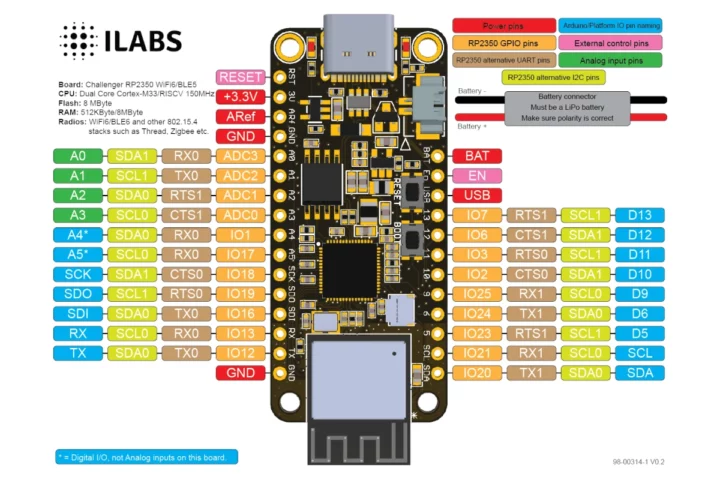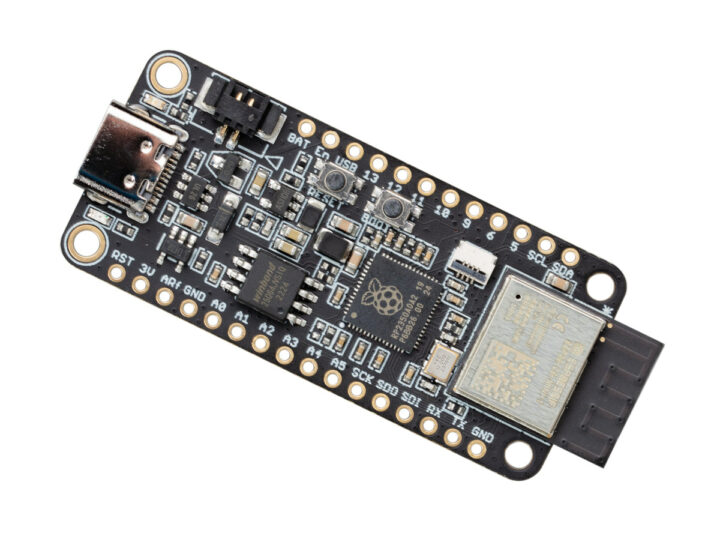You don’t need to wait for the Raspberry Pi Pico 2 W to get a Raspberry Pi RP2350 board with WiFi and Bluetooth thanks to the Challenger+ RP2350 WiFi6/BLE5 board that combines an RP2350A microcontroller with an ESP32-C6 module offering 2.4 GHz WiFi 6 and Bluetooth 5.4 LE connectivity.
The board follows the Adafruit Feather form factor with 28-pin through holes for I/Os making it compatible with FeatherWings add-on boards. It comes with a USB-C port for power and programming, and a JST connector plus a charging circuit for people wanting to connect a LiPo battery.
Challenger+ RP2350 WiFi6/BLE5 specifications:
- Microcontroller – Raspberry Pi RP2350A MCU
- CPU
- Dual-core Arm Cortex-M33 processor @ 150MHz
- Dual-core 32-bit RISC-V processor @ 150MHz
- Only two cores can be used at a given time
- Memory – 520KB internal RAM
- 8KB OTP Storage
- Package – QFN-60; 7×7 mm
- CPU
- Memory – 8MB PSRAM
- Storage – 8MB SPI flash @ 133 MHz
- Wireless Module – Espressif Systems ESP32-C6-MINI-1 connected to RP2350A over SPI and UART, plus 3x GPIO for control
- SoC – ESP32-C6H4 32-bit RISC-V microprocessor up to 160 MHz with 320KB ROM, 512KB HP SRAM, 16KB LP SRAM, 4MB flash
- Wireless
- 2.4 GHz WiFi 6 with Target Wake Time (TWT) support
- Bluetooth 5.4 LE and Mesh
- 802.15.4 radio with Zigbee, Thread, and Matter
- PCB Antenna
- USB – 1x USB 1.1 Type-C (12 Mbps) port for power, data, and programming
- Expansion
- 16-pin + 12-pin headers with
- Up to 16x GPIO
- 1x SPI, 1x I2C, 1x UART
- 4x analog inputs
- All pins can be used as PWM
- USB (5V), 3.3V, BAT, and GND
- 2x BConnect connectors (TBC, since no photo from the bottom, and I can only see one on the top)
- 16-pin + 12-pin headers with
- Misc
- Reset and Boot buttons
- Charging LED, user LED
- NEOpixel RGB LED (TBC)
- Power Supply
- 5V via USB-C port or “USB” pin (Schottky diode needed)
- 1.25mm pitch JST connector for LiPo battery
- Onboard LiPo charger with 500mA standard charge current
- Dimensions – 50.8 x 22.9 x 3.2 mm (Adafruit Feather form factor)
- Weight – 9 grams

The ESP32-C6 module is preloaded with ESP-AT firmware by default and is controlled by AT commands sent over UART from the Raspberry Pi RP2350, but also supports ESP-Hosted firmware through the SPI interface (work-in-progress). iLabs mentions support for Arduino/PlatformIO and CircuitPython for the Raspberry Pi RP2350. I’m surprised Arduino is mentioned, as other companies say it’s not available yet, but the explanation is that the Challenger+ RP2350 WiFi6/BLE5 relies on the arduino-pico-rp2350 repository currently in Alpha. Another location on the website says the board also supports the Raspberry Pi Pico C/C++ SDK, and MicroPython support is coming soon.
Additional information, including some documentation and Arduino code samples, may be found on the iLabs’ stores page where the board is sold for 249 Swedish Kronor (About $23.70 US). If you don’t need wireless connectivity, the company also introduced the Challenger+ RP2350 BConnect board available for 149 SEK or around $14.20 US.

Jean-Luc started CNX Software in 2010 as a part-time endeavor, before quitting his job as a software engineering manager, and starting to write daily news, and reviews full time later in 2011.
Support CNX Software! Donate via cryptocurrencies, become a Patron on Patreon, or purchase goods on Amazon or Aliexpress





